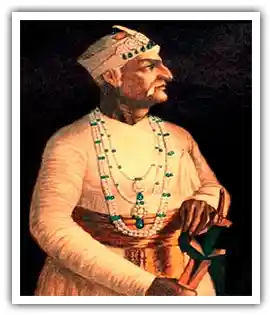When Tiger ate the Kulcha
No, this is not a story of any tiger who had the popular Indian bread for lunch but the story of the indirect annexation of Hyderabad, whose royal insignia was the ‘kulcha’, by Lord Wellesley, who referred to himself as the ‘Bengal Tiger’.

Nizam Ali Khan, the King, who signed away his freedom; Image Source: Public Domain
While Warren Hastings’ policy of creating a buffer state and Cornwallis’ usurpation of power of building and maintaining foreign relations had handicapped the autonomy of the Nizam state to a great extent, it was Lord Wellesley’s policy of subsidiary alliance that acted as the final nail in the coffin for the princely state of Hyderabad. Lord Wellesley, who called himself the ‘Bengal Tiger’, desired British supremacy over the entire subcontinent. Bengal had already been won over and attempts to annex Mysore, Carnatic, and Awadh were underway.
In the late 18th century, Wellesley felt that the situation was ripe to capture Hyderabad. But he was cautious enough to not launch a direct attack and carry it out through the diplomatic channel of the subsidiary alliance.
He signed the subsidiary alliance with Nizam Ali Khan or Asaf Jaha II, the Nizam of Hyderabad on September 1, 1798. A major role was played by the British Resident stationed at Hyderabad, Captain Achilles Kirkpatrick, who exerted immense pressure on the Nizam and convinced him to enter into the alliance with the Company in return for protection against external attack and internal rebellions.
In essence, Hyderabad became a vassal of the British Company, giving away an integral share of its power which in turn strengthened British colonial might. They were stripped of their power to forge or maintain relations with any other Indian kingdom. However, the British had promised that there would be no interference in the internal matters of the state but it was hardly kept.
According to the alliance, the allying Indian state, in this case, Hyderabad, was compelled to disband their own army and station a British force in their territory permanently. The state was also required to pay a subsidy for the maintenance of the army. In lieu of the cash payment, Wellesley introduced a new feature to take over a part of the state which usually accounted for one-third of the total area. This is how the British built their empire piece by piece, transitioning from trading to territorial conquerors.
The Subsidiary alliance also acted as the final blow to the French as the treaty included the removal of all French from the service of the state. As a result, the French General, Monsieur Raymond, employed in the Nizam army was removed along with other Frenchmen.
Hyderabad was the first Indian princely state to enter into an alliance with the English East India Company. They also supported the British attack against Tipu Sultan in the Fourth Anglo-Mysore War in 1799 and remained loyal to the British during the Sepoy Mutiny of 1857.
The autonomy of the state was compensated with a ceremonial honour of the 21-gun salute by the British; a privilege which was enjoyed by five princely states under British India. This status of Hyderabad state remained until its annexation by the Independent Government of India in 1948.


